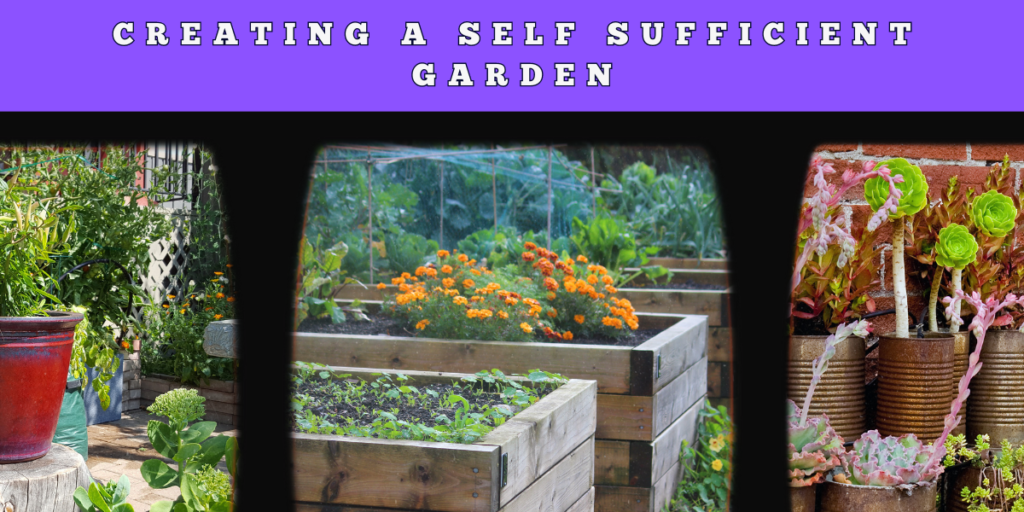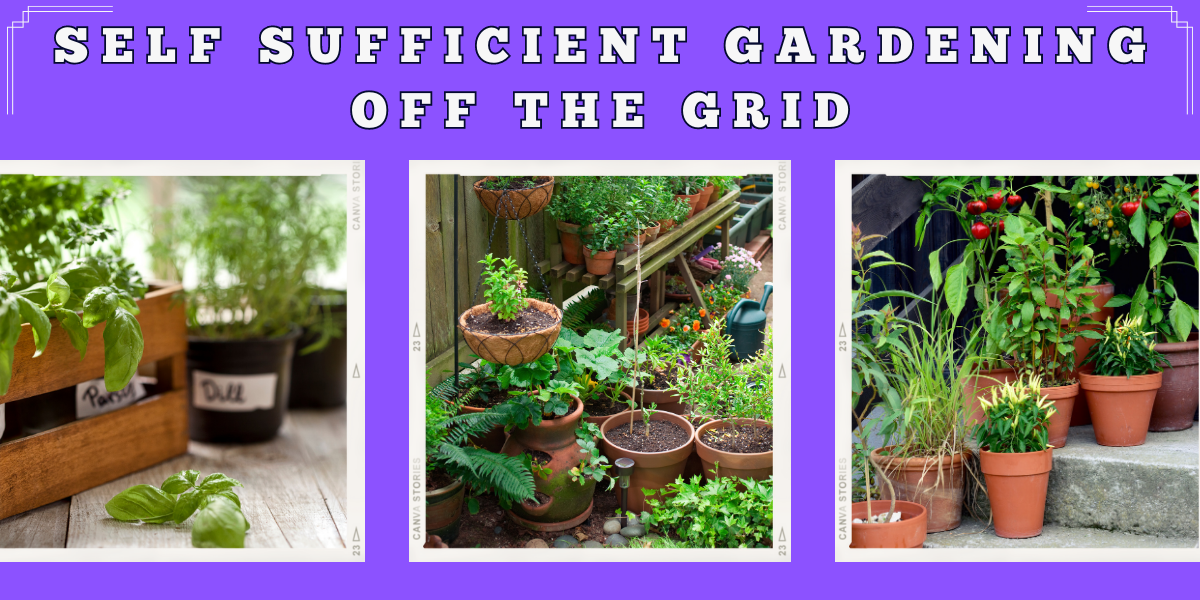Harvesting Independence: A City Girl’s Path to a Self Sufficient Garden
From City Life to Off-Grid Living
Just a few weeks ago, I was a city dweller, surrounded by the familiar privilege of indoor plumbing, reliable internet, and pizza on demand . Now, I find myself on the Kootenay boundary, embracing the rural life and dreaming of a self-sufficient garden. But dreams come with challenges. I have a well, but no power, and I’m away from Monday to Friday. So how do you keep a garden thriving in these conditions? Let’s delve into the journey!
The Joy and Challenges of Creating a Self Sufficient Garden… in Containers

Benefits of Container Gardening
Container gardening is an incredibly appealing option for many, but especially for those like me, who have an off-grid property and are limited to weekend tending. Here’s why:
- Flexibility: You can move the containers to take advantage of the sun, shade, or even bring them indoors if needed. This adaptability is particularly useful for seasonal changes or experimenting with different locations.
- Control over Soil and Nutrients: Containers allow you to create the perfect soil environment for each plant. Customizing the soil helps in managing nutrients and ensures that the plants get exactly what they need to thrive.
- Space-Saving: For those with limited land or even those who are planning to garden inside an RV, container gardening offers a space-saving solution that doesn’t sacrifice productivity.
- Creativity and Aesthetics: Container gardens can be arranged in visually appealing ways. You can choose containers that match your style and arrange them to create a garden that is as beautiful as it is functional.
- Potential for Year-Round Growing: With the right planning and container selection, you could have fresh produce year-round, even in an RV!
Challenges specific to Off-Grid Living
While container gardening offers numerous benefits, off-grid living(check out our post about geothermal heating and cooling) adds a layer of complexity, particularly when it comes to watering.
- Watering Without Power: With no power to operate the well pump and being away most of the week, traditional watering techniques are not applicable. Finding ways to keep the plants hydrated without daily attention is critical.
- Creative Watering Solutions: As I am in the planning stages, the gravity-fed drip irrigation system is one of the options I’m considering. This solution would allow me to use the well water without needing power, and it can be tailored to suit the needs of different plants.
- Weather Considerations: Off-grid locations may have unique weather patterns that need to be taken into account. Understanding how the wind, temperature, and precipitation in your area affect your garden will help in choosing the right plants and containers.
- Limited Resources: Living off-grid often means limited access to conventional gardening resources. This limitation requires more creativity, planning, and potentially a higher initial investment in the right tools and containers.
Watering Solutions: Making the Most of What’s Available
The Well Dilemma
For most of us city slickers, we just take it for granted that you hook up a sprinkler, add a timer, and blamo your garden is cared for while you’re at work or on vacation. Not so simple when living off the grid, my well pump requires power to operate, it also is either on or off, it doesn’t like any build-up of pressure and will pop a breaker even if there is power at the time. These are issues I will tackle down the road. For now I’m more interested in gravity drip irrigation.
Creative Solutions: Gravity-Fed Drip Irrigation System
I stumbled upon the concept of gravity-fed drip irrigation, and it was a revelation! Here’s how it works:
- Water Collection: The Kootenay boundary doesn’t get much rain, but I have the option of filling up an external tank and using that to supply the water system. There is also the option of rain barrel water collection.
- Storage Elevation: Whatever water storage system you use, needs to be elevated to let gravity do the work. The elevation allows the water to flow through hoses without the need for any power.
- Drip Hoses and Emitters: By connecting specialized drip hoses and emitters, I’ll be able to guide the water directly to the base of my plants.
- Timers and Regulation: Even without electricity, manual or battery-operated timers could be added to control the water flow as needed.
This system will be a game-changer. It’s affordable, ecological, and can keep my plants hydrated even when I’m away. Let’s just hope the deer don’t eat them all.
Other Weekend Gardener-Friendly Watering Techniques
But the gravity-fed system isn’t the only solution I plan to experiment with. Here are other methods that can be great for those who tend to their gardens mainly on the weekends:
- Water Globes: These attractive glass globes release water slowly into the soil. Just fill them up before leaving, and they’ll take care of the watering for a few days. Honestly these didn’t work very well for me, but I’m new to the whole gardening thing!
- Soaker Hoses: Laying out soaker hoses can provide slow and deep watering. They can also be connected to the gravity-fed system. Diving into research about laying the hoses out but having very small holes to allow for a steady flow of a small amount of water. Trial and error is my friend.
- Mulching: Applying mulch around your plants helps retain moisture, reducing the need for frequent watering. I have access to a large pile of wood chips that will eventually become mulch, the learning curve is tight here.
- Deep Watering Before Leaving: Giving plants a good soak before leaving can ensure they have enough water to last until you return. For me, this isn’t really an option, there are times when work will take me away for days or weeks at a time. Surely there will be someone in the area who can check on things for me, but being the new girl in a very small town means I don’t really have a network just yet.
Watering a garden while being away most of the week is a challenging problem to solve. But with a little ingenuity and willingness to try different methods, I’m sure to find solutions that fit my unique situation. Whether you have a well or not, these techniques can be applied to keep your plants happy and thriving.
Choosing the Right Plants: Easy-to-Grow Food for Weekend Tending
Tips for Selecting Resilient and Low-Maintenance Plants
Since I’m writing this post at the end of August, planting is not on the immediate horizon. The fall and winter months are a perfect time to plan, and choosing the right plants is a vital part of that process. Here are some tips:
- Seasonal Timing: Consider the time of year when you’ll be planting. Springtime is a great window for many vegetables and herbs.
- Weekend-Friendly: Select plants that can tolerate being alone during the weekdays. Look for those that are drought-resistant and don’t require daily care.
- Growth Duration: Consider the full growth cycle and choose plants that fit within your schedule, especially if you’re planting later in the season.
Easy-to-Grow Foods
Though I won’t be planting my self sufficient garden until spring, I have been doing my research and gathering some personal experiences from fellow gardeners. Here are some beginner-friendly plants that seem to be promising:
- Herbs: Many herbs like basil, mint, and oregano are hardy and can thrive with minimal care.
- Cherry Tomatoes: These are not only delicious but also resilient. They can do well with just weekend care.
- Leafy Greens: Plants like spinach and kale are forgiving and can make a great addition to the weekend gardener’s plot.
- Root Vegetables: Think about carrots and radishes. They grow below the ground and are often less demanding in terms of water.
Importance of Soil, Sunlight, and Containers
- Soil Quality: The right soil can make or break a garden. Look for nutrient-rich soil that provides good drainage. Adding compost can help.
- Sunlight: Be mindful of the sun’s path across your property. Select a spot for your containers that gets an appropriate amount of sunlight for the plants you choose.
- Containers: Since I’ll be focusing on a container garden, choosing the right pots is crucial. Different plants have different root space needs. Make sure to pick containers that provide enough space and proper drainage.
Planning a garden while being away most of the week is proving to be a challenge, one who’s execution is going to have to wait till next spring. Though the actual planting is months away, the planning stage is endless hours of research. I’m all about envisioning what can be, and putting the pieces together so that come spring, I’ll be ready to sow the seeds of a self-sufficient garden.
Vertical Indoor Container Gardens: A Year-Round Solution
If you’re eager to start your gardening journey immediately, even at the tail end of August, vertical indoor container gardens might be the answer. They’re space-efficient, aesthetic, and allow you to grow plants year-round. Here’s what you need to know:
Advantages of Vertical Indoor Gardening
- Space-Saving: Vertical gardens take advantage of vertical space, making them perfect for small apartments or limited outdoor areas.
- Year-Round Growing: Unlike outdoor gardens, indoor vertical gardens are not limited by seasons, allowing for continual harvesting.
- Controlled Environment: You can control light, temperature, and humidity, ensuring optimal growth conditions.
What to Grow in a Vertical Indoor Container Garden
Certain plants thrive in vertical indoor environments. If you want to plant an indoor garden right now, consider the following:
- Herbs: Basil, thyme, mint, and parsley are wonderful for indoor vertical gardens. They enjoy the stable conditions and can provide fresh flavours for your cooking year-round.
- Leafy Greens: Spinach, lettuce, and arugula grow well in vertical setups. They require less space and can be harvested continually.
- Strawberries: Believe it or not, strawberries can be an excellent choice for vertical indoor gardens. They love the sunlight and can produce fruit even indoors.
- Edible Flowers: Add some colour with edible flowers like violets and marigolds. They bring beauty and unique flavours to your garden and plate.
Tips for Successful Vertical Indoor Container Gardening
- Choosing the Right Containers: Pick containers that are deep enough for the roots but light enough for the vertical structure. Consider using specialized vertical gardening planters.
- Lighting: If natural sunlight is limited, invest in quality grow lights to provide the necessary spectrum of light.
- Watering: Drip irrigation can also be adapted for indoor use, or hand-watering can be effective if managed properly.
- Soil & Nutrients: Quality potting soil with the right blend of nutrients will ensure healthy growth. Regular feeding with an all-purpose organic fertilizer is often beneficial.
Self Sufficient Garden: Embarking on a Journey
The Vision of Learning and Growth: More Than Just Food
This container garden project isn’t just about producing food; it’s about finding ways to overcome the challenges. As I research and prepare, I’m already discovering lessons in resilience, planning, and innovation. It’s a venture filled with promise and one that resonates with my transformation from city girl to rural enthusiast.
The thought of growing my food is super exciting and very empowering. It promises not just fresh, homegrown produce but a sense of accomplishment and self-reliance. The indoor vertical garden, in particular, is an enticing prospect for my winter travels down south in my van. I have a vision of tending herbs and leafy greens, even on the road. The idea of being able to nourish myself with the literal fruits of my labour is a thrilling aspect of this journey toward self-sufficiency and frugality.
A Special Note on My Future Indoor Vertical Garden: On-the-Road Gardening
Imagine having fresh basil or mint right in the van, accessible at any time! I love the idea of having an indoor garden that I can easily move between my big RV and my van. Here’s what I’m considering:
- Space Utilization: Finding the right spot that provides stability, light, and aesthetics. Anyone living full-time van life understands that space is the hottest commodity. I’m thinking I will do a hanging vertical planter in my bathroom, it is nice and bright in there, there will be the added bonus of humidity after showering, and it will be easy to water and contain any drips.
- Plant Selection: Choosing herbs and small plants that will thrive indoors and suit my culinary needs. There will definitely be veggies, tomatoes, hopefully lettuce. Growing green onions is super simple and can be done anywhere by simply buying a few and planting the bulbs when you are done chopping them up.
- Watering System: Exploring simple watering solutions that will keep the plants hydrated while I’m driving or away from the van. A little more research into this is required. Water will not be in abundant supply on my journey.
- Community Input: I would love to hear from anyone who has experience with van gardening or has tried similar projects.
Embarking on this self sufficient garden adventure, both at my off-grid property and on the road, fills me with anticipation. It’s a new chapter in my story of growth, adaptation, and embracing a life less ordinary. Join me, share with me, and let’s cultivate our dreams together.





